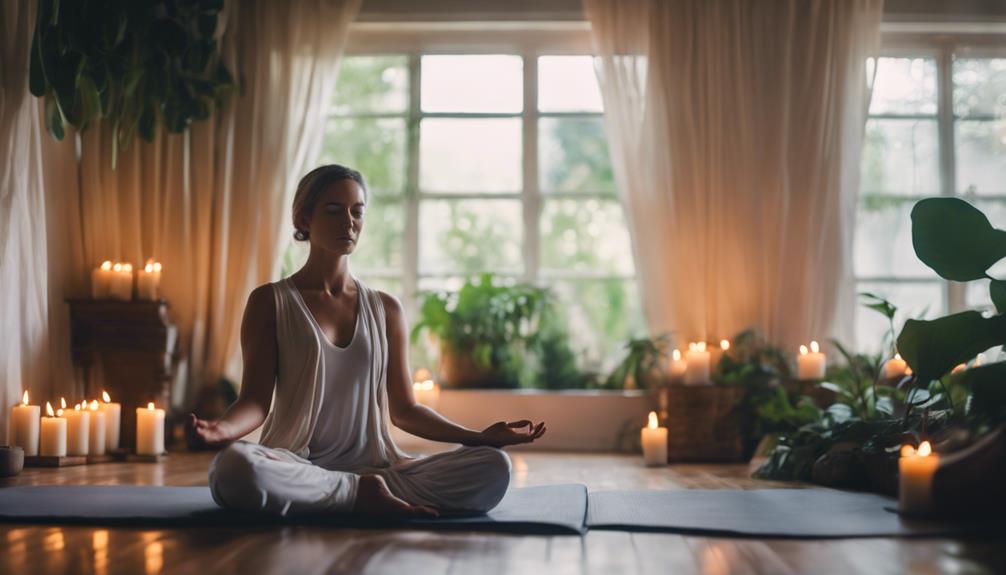Somatic yoga is gaining popularity for its unique approach to combining movement and mindfulness. Unlike traditional yoga, which often emphasizes posture and alignment, somatic yoga focuses on the internal experience of movement. This practice invites you to explore the sensations within your body, promoting a deeper connection between mind and body. If you’re curious about how somatic yoga can enhance your well-being, you’re in the right place! In this article, we’ll explore the benefits, essential tools, and even provide downloadable resources to help you get started on your somatic yoga journey.
What is Somatic Yoga and Why Should You Try It?
Somatic yoga is a holistic practice that integrates yoga with somatic awareness, which is essentially the body’s internal sense of itself. This form of yoga encourages participants to pay close attention to their body’s sensations, movements, and emotions. Through gentle, mindful movements, practitioners can release tension, improve flexibility, and cultivate a greater sense of presence. It’s perfect for anyone looking to deepen their yoga practice or those who may feel overwhelmed by the more vigorous styles of yoga.Yoga In The Park Pittsburgh
So, why should you give somatic yoga a shot? Beyond the physical benefits, somatic yoga invites a unique exploration of your emotional landscape. Many practitioners find that this deeper awareness helps to alleviate stress and anxiety, making it an excellent choice for anyone seeking relaxation or emotional balance. Whether you’re a seasoned yoga enthusiast or a complete beginner, somatic yoga offers an accessible entry point to connect with your body and mind.
Key Benefits of Somatic Yoga for Your Mind and Body
Engaging in somatic yoga can lead to numerous benefits for both your mind and body. Physically, the practice promotes increased flexibility, strength, and coordination. The slow, mindful movements help to release chronic tension and improve posture, ultimately leading to a more balanced and aligned body. This practice also emphasizes the importance of listening to your body, which can help you discover areas of tightness or discomfort that need attention.
On a mental level, somatic yoga cultivates mindfulness and self-awareness. As you focus on the sensations within your body, you may find that your stress levels decrease, and your mood improves. Many practitioners have reported feelings of calm and relaxation that linger long after their sessions. By creating a compassionate dialogue with your body, somatic yoga can lead to profound emotional healing and resilience.
Getting Started: Essential Tools for Somatic Yoga
Starting your somatic yoga journey doesn’t require fancy equipment, but having the right tools can enhance your experience. A yoga mat is essential for providing a comfortable surface to practice on, while props such as blocks, straps, or cushions can offer support and stability during your movements. If you’re practicing at home, consider investing in a few essentials that make your space cozy and inviting; a blanket can be great for added comfort during seated or restorative poses.
Another helpful tool is a journal. After your somatic yoga practice, you may want to jot down any insights or sensations experienced during your session. This can enhance your self-awareness and help you track your progress over time. Remember, somatic yoga is about tuning into your own experience, so feel free to get creative with your tools and props to find what feels best for you!
A Simple Guide to Somatic Yoga Exercises for Beginners
If you’re new to somatic yoga, it can be helpful to start with a few simple exercises that foster awareness and relaxation. One great exercise is the "Body Scan," where you lie comfortably on your back and slowly bring your attention to different parts of your body, noticing any sensations or areas of tension. This practice helps promote a sense of grounding and connection to your body.
Another excellent beginner exercise is "Gentle Neck Rolls." While seated or standing, allow your head to gently roll in circles, paying close attention to how each movement feels. These simple exercises can be a fantastic way to ease into somatic yoga and cultivate a greater awareness of your body. As you grow more comfortable, you can gradually explore more complex movements and poses.
Downloadable PDFs: Your Somatic Yoga Exercise Resources
To help you dive deeper into somatic yoga, many resources are available in downloadable PDF formats. These PDFs often include guided exercises, sequences, and helpful tips for both beginners and experienced practitioners. They can serve as a fantastic reference point for your practice, allowing you to revisit and explore different exercises at your own pace.
You can find a variety of somatic yoga PDFs online, often created by experienced instructors who specialize in this unique approach. By having these resources at your fingertips, you can more easily integrate somatic yoga into your routine, enhancing your overall experience and understanding of the practice.
Top 5 Somatic Yoga Poses to Relieve Tension
If you’re looking to relieve tension, certain somatic yoga poses can be especially effective. Here are five poses to consider incorporating into your practice:
- Cat-Cow Stretch: This gentle flow between arching and rounding the back helps to release tension in the spine and neck.
- Child’s Pose: A restorative pose that encourages relaxation and a gentle stretch through the back and hips.
- Seated Forward Bend: This pose promotes lengthening in the spine and hamstrings, while also allowing for a calming forward fold.
- Lying Spinal Twist: This pose helps to release tightness in the back and hips, while promoting overall relaxation.
- Legs Up the Wall: A restorative pose that promotes relaxation and reduces tension in the legs and lower back.
Experiment with these poses, and pay attention to how each one feels in your body. Remember, somatic yoga encourages you to move in a way that feels good, so don’t hesitate to adjust or modify any pose to suit your needs.
How to Create a Relaxing Space for Your Practice
Creating a calming environment for somatic yoga can significantly enhance your experience. Start by finding a quiet, clutter-free space where you can practice without distractions. Good lighting is important; consider soft, natural light or candlelight, which can help create a more serene atmosphere.
Adding personal touches can also make your space feel inviting. Consider incorporating plants, soothing colors, or meaningful objects that inspire you. Soft textures, such as blankets or cushions, can create a cozy atmosphere, allowing you to relax and fully immerse yourself in your practice. The goal is to create a space that feels safe and nurturing—your sanctuary for exploration and self-discovery.
Tips for Incorporating Somatic Yoga into Daily Life
Incorporating somatic yoga into your daily routine doesn’t have to be daunting. Start by setting aside just a few minutes each day to practice mindful movement and awareness. You can engage in somatic exercises first thing in the morning or as a calming activity before bed. Even brief sessions can have a significant impact on your well-being.
Additionally, consider integrating somatic principles into your daily activities. Whether you’re walking, cooking, or even sitting at your desk, try to maintain a connection with your body—notice the sensations, the rhythm of your movements, and the breath flowing through you. This mindful approach can help you cultivate a more profound sense of presence and connection throughout your day.
Common Mistakes to Avoid When Doing Somatic Yoga
While somatic yoga is designed to be gentle and accessible, there are a few common mistakes that beginners should avoid. One of the most significant pitfalls is rushing through movements without taking the time to tune into your body. Remember, somatic yoga is about the journey, not the destination. Focus on the sensations and emotions that arise during your practice, and allow yourself the freedom to move at your own pace.
Another common mistake is comparing your practice to others. Somatic yoga is deeply personal, and each person’s experience will be unique. Instead of striving for a perfect pose or a specific outcome, embrace where you are in your journey. This mindset will help you cultivate a more enriching and fulfilling practice.
Join the Community: Share Your Somatic Yoga Journey!
One of the most rewarding aspects of practicing somatic yoga is the sense of community that surrounds it. Many practitioners find that sharing their experiences, challenges, and triumphs with others adds depth and richness to their journey. Consider joining local classes, online forums, or social media groups focused on somatic yoga. Engaging with others can provide support, inspiration, and valuable insights.
Don’t hesitate to share your experiences with friends and family as well! You might inspire someone else to embark on their somatic yoga journey. Remember, yoga is more than just a practice—it’s about connection, growth, and community. Embrace the opportunity to learn from one another and celebrate your unique paths!
Somatic yoga is more than just a physical practice; it’s a journey into self-discovery, healing, and mindfulness. With its focus on internal awareness, this approach offers a refreshing alternative to traditional styles of yoga. As you explore the benefits of somatic yoga, remember to take your time, listen to your body, and enjoy the process. Whether you’re just starting or have been practicing for years, there’s always something new to discover. So, roll out your mat, download those PDFs, and begin your adventure in somatic yoga today!


